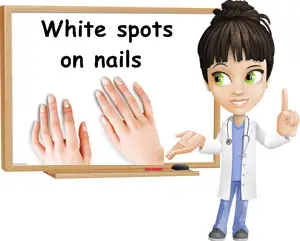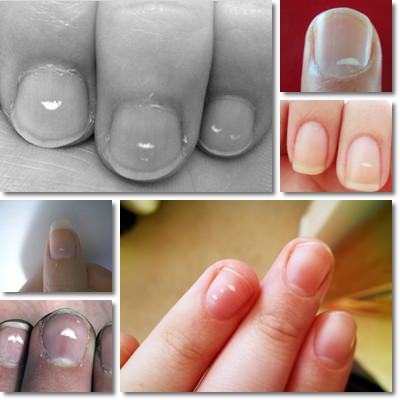Many of us have often had to deal with tiny white spots appearing on the surface of our nails and maybe didn’t know what caused them or how to make them disappear. While they are not a cosmetic emergency, white spots on nails become worrisome because they depict a change in our body for which we have no clear explanation. Generally, the white spots many of us get on nails disappear with time, without causing harm or even bothering us.
However, they can also indicate there may be something wrong, whether it’s nutrient deficiencies, bacterial or fungal infections. White spots on nails are almost always benign and rarely indicate serious health problems. Even when they are a symptom of nutrient deficiencies, they can be remedied easily by simple dietary changes. For them to indicate a serious medical condition they would have to be accompanied by other, more visible symptoms of illness.

However, most of the time, these tiny white dots disappear as the nail grows, but it can take several weeks to months for this to happen. Some experts say that the condition is caused by either a lack of calcium in the diet, or a zinc deficit. But while a generous intake of vitamins and minerals does contribute to healthy, beautiful, spot-free nails, some medical professionals strongly believe that mineral deficiencies do not directly cause the condition. So why do we get white spots on nails? What causes them and should we be worried? Find out below what it is you should know about what causes white spots, dots, marks and lines on nails.
What causes white spots on nails?
Injury and trauma
You probably have banged or knocked your fingers on something at one point, forgot all about it and some days or weeks later you see one or two white spots on your fingernails. Accidentally catching a finger in the cupboard door or pushing or lifting a heavy object with the tips of your fingers can hurt your nails. Wearing tight or uncomfortable shoes does the same for your toenails. Using nail tip cutters inappropriately may cause injury as well.
Hurting the already grown nail often results in it breaking, but trauma from hurting the base of the nail is not immediately visible. Only after several weeks does the nail grown from the injured base show signs of trauma, namely white spots, dots or marks. Unless you are particularly clumsy like me, these should be rare occurrences.

A potential infection
White spots, dots or marks on fingernails or toenails may indicate a bacterial, yeast or fungal infection. However, nail infections are often accompanied by other telling symptoms such as itching, rashes, redness or bad smells and usually damage the nail structure, causing flaking or breaking at the top.
Allergic reaction
Although these are not your usual allergies, allergic reactions located at the level of the nails (either fingernails or toenails) are often a bad response to hands or feet care products such as nail polish, base coats, top coats, nail treatments, nail polish remover, even hand and feet lotions and creams etc. Not all nails are the same and some are more sensitive than others. Manicures or pedicures can be very traumatic for them and should be enjoyed with moderation.
Nutrient deficiencies
Experts are not on the same page when it comes to white marks on nails being caused by nutrient deficiencies. Some assert that a lack of dietary zinc or calcium can lead to white spots. Others consider vitamin C deficiency to also be a cause because the nutrient stimulates the production of collagen, a protein necessary for the healthy growth of basically every tissue in our body, nails included. However, there is no clear connection between the lack of a certain nutrient, be it vitamin or mineral, and the occurrence of white spots.
At the same time, having a generous intake of nutrients ensures strong, healthy, beautiful nails from the beginning. Just as calcium or zinc deficiency causing white marks on nails is a myth, so is the recommendation to cover your nails with vitamin-enriched polish. The best thing you can do to keep your nails healthy is to eat well: varied and natural. What we eat shows on the outside as well, through a healthy body and a sane mind.
Arsenic or lead exposure
Ingesting even trace amounts of arsenic can be dangerous for our health. A slow arsenic poisoning, achieved through diet (fish, cereals) and water mostly, may not exhibit clear or worrisome symptoms from the beginning. Gastrointestinal and nervous system problems, kidney, liver and heart conditions as well as pigmentation or depigmentation of the skin are signs of a too high arsenic intake. White traces on nails may also fit into this category.
Lead poisoning, achieved through prolonged exposure to trace amounts of the metal, can severely affect the nervous system and trigger digestive and kidney problems. It is believed to be a cause of white spots on nails as well.
Disease
Although rare, white dots, spots or marks on nails may be a sign of more serious health problems such as psoriasis, herpes, malaria, even leprosy, low blood supply to the extremities, liver or kidney problems, malabsorption or genetic predisposition to certain conditions. If the entire nail starts to become white, then you should immediately go see a doctor.
Conclusion
Tiny, white spots on nails are usually caused by injuries, in which case you just have to wait for the nail to outgrow the mark. Improving your diet can contribute to healthier, better looking nails from the start because you will enjoy better health from better eating and it will show on your nails as well. If required, you can meet your daily vitamin and mineral needs through the use of dietary supplements. Vitamin C is an especially useful nutrient because our body uses it for almost everything, from tissues to blood vessels and skin to nails. However, if you notice other disturbing symptoms along with white spots, dots or marks on your nails, a visit to the doctor is imperative.
